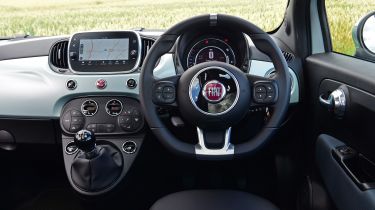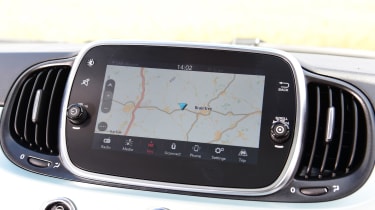Fiat 500 Hybrid - Interior, design and technology
The 500 offers retro-styling in a small package, along with a reasonable level of standard kit

This generation of Fiat 500 was first launched in 2007, and it remained largely unchanged until summer 2016 when Fiat tweaked the looks inside and out. At the front, the refreshed 500 got an extra chrome strip — reminiscent of the larger 500X SUV — and new larger elliptical daytime-running lights. To the rear, ring-shaped light clusters with body-coloured centres were added. Very little has changed since then, though.
In terms of spec, the standard 500 Hybrid gets 15-inch alloy wheels, LED daytime driving lights on the outside, while the interior features a seven-inch touchscreen infotainment system, air-conditioning and cruise control.
Moving up to the 500 TOP adds in a few extra goodies such as larger 16-inch alloy wheels, rear parking sensors, automatic climate control and a digital dashboard display.
Customisation has long been the theme with Fiat’s city car, so there’s a reasonable amount of personalisation options to choose from. Stripes, a chequered roof, chrome door mirrors and even key covers are just some of the add-ons that can help your 500 Hybrid stand out, but these will drive up the cost.
One problem that has continuously plagued this generation of 500 is the material quality. Some interior plastics are pleasing to the eye and touch, but there’s also some rather nasty door finishes and flimsier trim further down the dash. Fit-and-finish isn’t amazing in some areas, either.
Sat-nav, stereo and infotainment
Both the standard and TOP trims get the same 7-inch touchscreen infotainment system with Apple CarPlay, Android Auto, Bluetooth, USB and DAB functionality.
The combination of buttons, dials and touchscreen interface means this system is easy enough to use, and the optional sat-nav is clear enough, but it’s far from being the most modern system on today’s market.
TOP spec cars also get a 7-inch TFT display in the instrument binnacle which displays graphics representing the status of the hybrid powertrain systems.









